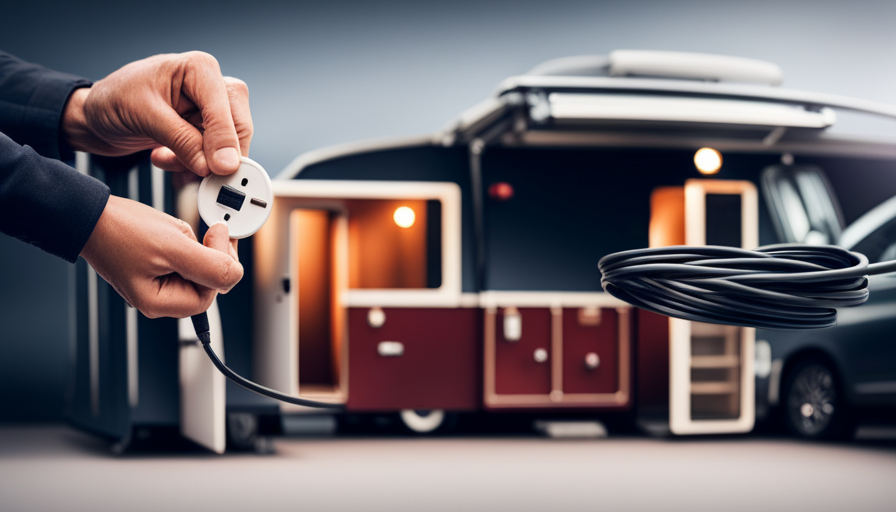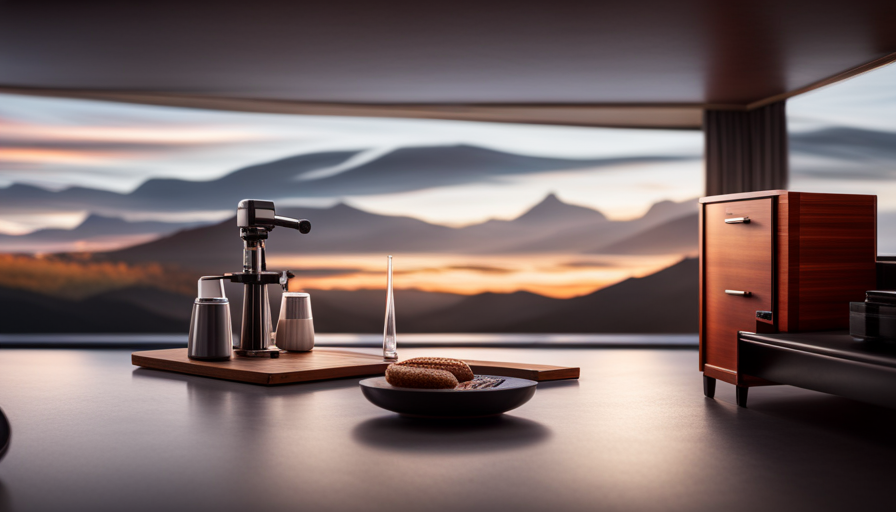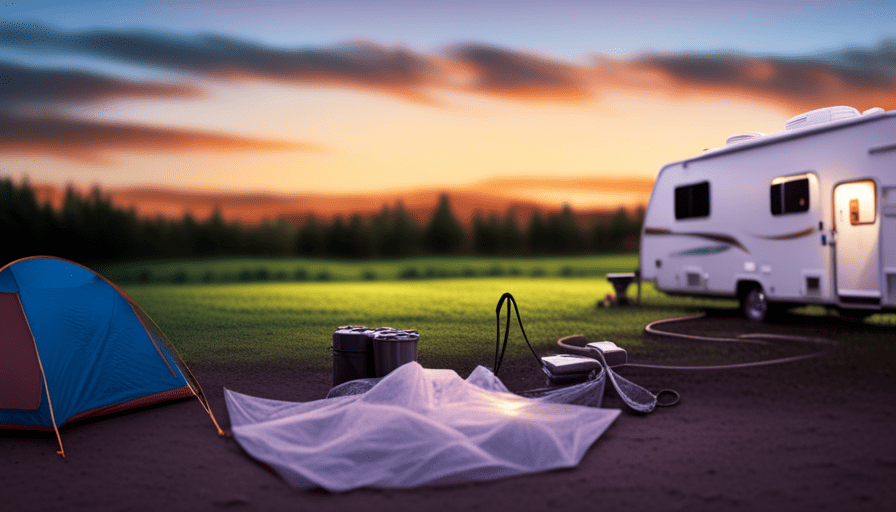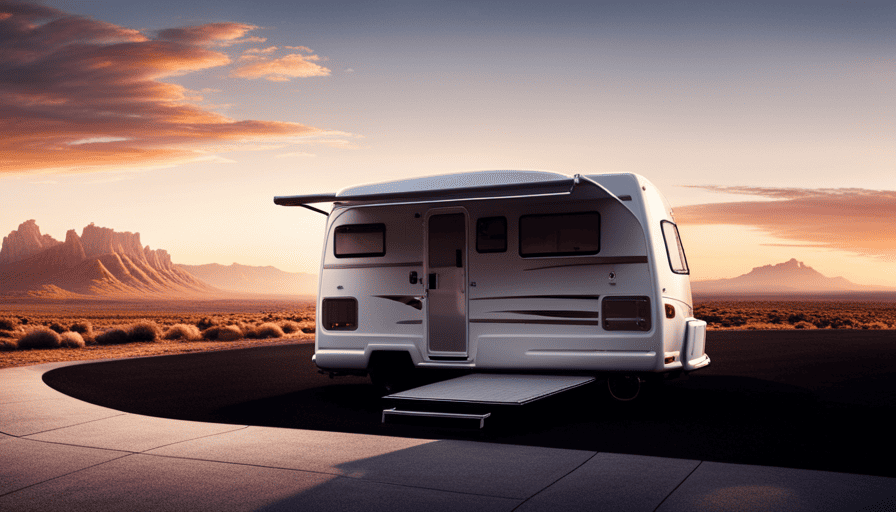Connecting your camper to power may appear straightforward, but believe me, it makes all the difference! Imagine this scenario: you’re cruising down the highway, discovering new places, when you stumble upon the ideal spot to set up camp. Now, it’s time to hook up and revel in all the conveniences of home. No need to worry, fellow explorers, as I am here to walk you through the steps of connecting your camper like a seasoned pro.
In this article, I will walk you through each step with precision and clarity. We’ll start by understanding your camper’s electrical system and choosing the right power source. Then, I’ll show you how to locate the power inlet on your camper and prepare the power cord for connection.
Once we’re all set, we’ll connect the power cord to the power source and test the connection for a seamless power supply. And of course, I’ll share tips on how to secure the power cord and monitor your power usage.
So, whether you’re a seasoned camper or a novice adventurer, join me on this electrifying journey to master the art of plugging in your camper!
Key Takeaways
- Understanding the camper’s electrical system is important for troubleshooting and safety.
- Ensure power cord and power inlet are inspected for damage and properly connected.
- Use the appropriate power source for the camper (shore power, generator, solar power, battery power).
- Regularly inspect and maintain the power cord for wear or damage.
Understand Your Camper’s Electrical System
Now let’s dive into understanding how your camper’s electrical system works so you can confidently plug it in. It’s important to familiarize yourself with the electrical system to troubleshoot common electrical issues and take safety precautions when plugging in your camper.
First, let’s talk about troubleshooting common electrical issues. Before plugging in your camper, it’s crucial to check for any loose or damaged wires. Faulty wiring can cause electrical problems and even pose a safety hazard. Additionally, ensure that all circuit breakers and fuses are in working order. If you encounter any electrical issues while plugging in or using your camper, it’s best to consult a professional electrician or contact the manufacturer for assistance.
Next, let’s discuss safety precautions for plugging in a camper. Always make sure to turn off the power source before connecting your camper to avoid any electrical shock. Additionally, use a properly rated power cord and ensure it’s in good condition without any signs of fraying or damage. It’s also a good idea to use a surge protector to protect your camper’s electrical system from voltage spikes.
Understanding your camper’s electrical system and taking necessary safety precautions are essential for a smooth and safe camping experience. Now, let’s move on to the next section about choosing the right power source for your camper.
Choose the Right Power Source
First, make sure you’ve selected the appropriate power source for your mobile home. When it comes to plugging in a camper, there are different types of power sources you can choose from. Each power source has its own advantages and considerations. To help you understand better, here is a table comparing the different power sources commonly used for campers:
| Power Source | Description |
|---|---|
| Shore Power | Connects your camper to a power pedestal at a campground or RV park. It provides a reliable source of electricity. |
| Generator | A portable power generator that can be used when you are boondocking or camping off-grid. It requires fuel to operate. |
| Solar Power | Uses solar panels to convert sunlight into electricity. It is environmentally friendly and ideal for off-grid camping. |
| Battery Power | Utilizes a battery bank to store electricity. It is commonly used in combination with other power sources. |
When plugging in your camper, it is important to avoid common mistakes. One mistake is not checking the power source’s voltage compatibility with your camper’s electrical system. Another mistake is not using the appropriate adapters or connectors. Lastly, forgetting to turn off all appliances and systems before connecting to the power source can lead to electrical issues.
Now that you understand the different power sources, let’s move on to the next step: locating the power inlet on your camper.
Locate the Power Inlet on Your Camper
Have you ever wondered where you can find the power inlet on your mobile home? Well, let me guide you through this crucial step of plugging in your camper.
The power inlet is usually located on the exterior of your camper, and it serves as the connection point between your camper and the power source. Here are some important tips to keep in mind regarding your camper’s power inlet:
- Regularly inspect the power inlet for any signs of damage or wear.
- Clean the power inlet regularly to remove any dirt or debris that could interfere with the connection.
- Avoid using excessive force when plugging in or unplugging the power cord to prevent damage to the power inlet.
- Ensure that the power inlet is properly sealed to prevent water from entering and causing electrical issues.
- Consider using a power inlet cover to provide extra protection against the elements.
When plugging in your camper, it’s essential to avoid some common mistakes, such as using an incorrect power source or not properly aligning the plug with the power inlet. These mistakes can lead to electrical damage and pose a safety risk.
Now that you know where to locate your camper’s power inlet, let’s move on to the next step of preparing the power cord.
Prepare the Power Cord
Get ready to handle the essential task of prepping your power cord, ensuring a smooth and safe connection for your mobile home’s electrical needs.
The first step is to select the appropriate power cord for your camper. Check the power requirements of your camper and choose a cord that matches those specifications. It’s crucial to use the right cord to prevent any electrical issues or damage to your camper’s electrical system.
Once you have the correct power cord, carefully inspect it for any damages. Look for any frayed wires, cuts, or exposed insulation. These can pose serious safety risks and should be addressed before plugging in your camper. If you notice any damage, it’s best to replace the cord to avoid any potential hazards.
After ensuring that the power cord is in good condition, you’re now ready to connect it to the power source. But before we dive into that, let’s briefly discuss the next step: locating the power source and understanding its requirements. This will ensure a successful connection and prevent any issues with your camper’s electrical system.
Now that you’ve prepared your power cord, let’s move on to connecting it to the power source and providing your camper with the electricity it needs.
Connect the Power Cord to the Power Source
Once you’ve located the power source, simply slide the power cord into place, ensuring a secure and reliable connection for your mobile home’s electrical needs.
To safely plug in a camper, there are a few steps you should follow to avoid any potential damage to the power cord. First, make sure the power source is turned off before plugging in the cord. This will prevent any electrical shocks or short circuits.
Next, inspect the power cord for any signs of wear or damage. If you notice any frayed wires or exposed insulation, it’s important to replace the cord before plugging it in.
Once you’ve confirmed the cord is in good condition, align the prongs on the plug with the corresponding slots on the power source. Apply gentle pressure and push the plug into place until you hear a click, indicating a secure connection.
Finally, give the cord a slight tug to ensure it is firmly in place. This will help prevent accidental disconnection while you’re using your camper’s electrical system.
With the power cord securely connected to the power source, you can now move on to the next step of plugging it into your camper.
Plug the Power Cord into Your Camper
Now, it’s time to connect the lifeblood of your mobile home – the power cord – to ensure your cozy haven is energized and ready for your adventures.
Before plugging in the power cord, it’s important to take some safety precautions. First, check that the power source is turned off to avoid any electrical mishaps. Inspect the power cord for any signs of damage such as frayed wires or exposed insulation. If you notice any issues, don’t use the cord and replace it immediately. Also, make sure the outlet you’re plugging into is compatible with your camper’s power requirements.
To plug the power cord into your camper, locate the external power inlet on the side or rear of your vehicle. Open the protective cover and align the prongs on the power cord with the slots in the inlet. Firmly push the cord into the inlet until it locks into place. Once connected, close the protective cover to keep out dirt and moisture.
If you encounter any common issues when connecting the power cord, such as a loose connection or a tripped circuit breaker, troubleshoot by checking for loose wires or resetting the breaker. It’s also a good idea to have a backup power cord in case of emergencies.
With the power cord securely plugged into your camper, it’s time to test the connection and make sure everything is functioning properly.
Test the Connection
After plugging the power cord into your camper, the next step is to test the connection to ensure a proper electrical supply. This step is crucial as it helps you identify any potential issues before you start using your camper.
To check the power connection, first, make sure that the power source you’re connected to is turned on. Then, go inside your camper and turn on the main power switch. If everything’s connected correctly, you should see the lights and appliances inside the camper come to life.
If you don’t have any power, there may be some troubleshooting steps you can take. Start by checking the main breaker in your camper’s electrical panel to see if it’s tripped. If it has, simply reset it and try again. If the breaker keeps tripping, there may be an issue with your camper’s electrical system that requires professional attention.
Once you’ve confirmed that the power connection is working, you can move on to securing the power cord to prevent accidental disconnection. This step is important to ensure a continuous supply of electricity to your camper.
Now, let’s move on to the next section about how to secure the power cord.
Secure the Power Cord
To ensure a continuous electrical supply, it’s important to securely fasten the power cord. Properly securing the power cord not only prevents it from getting damaged but also ensures that it remains connected throughout your camping trip.
Here are some important points to consider when securing your power cord:
-
Power cord storage: Before plugging in your camper, make sure the power cord is neatly coiled and stored in a dry and safe place. This helps prevent tangles and potential damage to the cord.
-
Power cord maintenance: Regularly inspect the power cord for any signs of wear or damage. Look for frayed wires, cracks, or exposed insulation. If you notice any issues, it’s important to replace the cord before using it.
-
Use a dedicated outlet: When plugging in the power cord, use a dedicated outlet that is specifically designed for RV use. This ensures a safe and reliable connection.
-
Secure connections: Ensure that the power cord is securely plugged into both the camper’s electrical inlet and the campground’s power source. Double-check the connections to avoid any loose or faulty connections.
-
Protect from elements: To protect the power cord from harsh weather conditions, use a weatherproof cover or place it in a designated cord protector. This helps prolong the lifespan of the cord.
By securely fastening the power cord and following proper maintenance practices, you can ensure a reliable electrical supply during your camping trip. Monitoring the power usage is the next step to optimize your camper’s electrical system and avoid overloading it.
Monitor the Power Usage
Keep an eye on your power usage to ensure an efficient and worry-free camping experience. Monitoring power consumption is crucial as it helps you troubleshoot any power issues that may arise during your trip. By keeping track of how much power you are using, you can avoid overloading the electrical system of your camper and prevent any potential damage.
To help you monitor your power usage, use the table below as a guide:
| Appliance | Power Consumption (Watts) | Usage (Hours/Day) | Daily Power Consumption (Watt-hours) |
|---|---|---|---|
| Air Conditioner | 1500 | 5 | 7500 |
| Refrigerator | 150 | 24 | 3600 |
| Lights | 60 | 4 | 240 |
| Water Pump | 100 | 1 | 100 |
| TV | 200 | 3 | 600 |
| Total Daily Usage | 12040 |
By monitoring your power consumption using this table, you can ensure that you don’t exceed the capacity of your camper’s electrical system. This will help prevent any potential power issues and ensure a smooth camping experience.
To disconnect your camper, simply follow the steps outlined in the next section.
Disconnecting Your Camper
Now that we’ve discussed how to monitor the power usage in your camper, let’s move on to the next step: disconnecting your camper. This is an important task that should be done properly to ensure a smooth and safe journey.
Before disconnecting your camper, it’s crucial to prepare for your camping trip. Make sure all your belongings are secured and stowed away properly. Check that all windows and doors are closed and locked. Double-check that your water and propane tanks are turned off to prevent any leaks.
Once you’re ready to hit the road, it’s important to drive safely with your camper. Remember that driving with a camper is different from driving a regular vehicle. Take your time and maintain a safe speed. Be aware of the extra weight and height of your camper, especially when turning or changing lanes. Give yourself plenty of space between other vehicles and use your mirrors to check your blind spots frequently.
By following these steps, you can ensure a smooth and enjoyable camping trip. Safe travels!
Frequently Asked Questions
How do I know if my camper’s electrical system is compatible with the power source?
To troubleshoot electrical issues in a camper, start by checking if the camper’s electrical system is compatible with the power source. Ensure that the voltage and amperage requirements of the camper match the power source, whether it’s a generator or another power supply.
You can consult the camper’s manual or contact the manufacturer for specific information. If the power source meets the requirements, you can safely use it to plug in your camper and power its electrical system.
What type of power source should I choose for my camper?
To choose the right power source for my camper, I must consider solar power and generator power. Solar power is a sustainable option that harnesses energy from the sun, making it ideal for off-grid camping. It requires solar panels and a battery system to store the energy.
On the other hand, generator power provides a reliable source of electricity, especially when camping in areas without sunlight. It uses fuel to generate electricity, ensuring a continuous power supply for my camper.
Is it possible to relocate the power inlet on my camper?
Yes, it’s possible to relocate the power inlet on your camper through camper modifications. By relocating the power inlet, you can choose a more convenient and accessible location for plugging in your camper. This can be useful if the current location isn’t ideal or if you want to make other modifications to your camper’s electrical system. It’s important to consult a professional or refer to your camper’s manual for proper instructions and safety precautions when undertaking such modifications.
How do I properly prepare the power cord before connecting it to the power source?
Before connecting the power cord to the power source, it’s important to properly prepare it. Start by inspecting the power cord for any visible damage or frayed wires.
Next, ensure that the power source matches the voltage requirements of your camper. Once confirmed, connect the appropriate end of the power cord to the power source securely.
Finally, double-check all connections and make sure that the power source is turned off before plugging in the camper.
What should I do if I encounter issues with the connection after plugging the power cord into my camper?
If I encounter issues with the connection after plugging the power cord into my camper, there are a few troubleshooting steps I can take.
First, I’ll check the circuit breaker to ensure it hasn’t tripped.
If that’s not the issue, I’ll inspect the power cord for any damage or loose connections.
Additionally, I’ll double-check that the power source is providing a stable and appropriate voltage.
It’s crucial to follow safety precautions throughout this process to avoid any electrical hazards.
Conclusion
After successfully plugging in your camper and ensuring a secure connection, you’re ready to embark on your adventure with electrifying confidence!
Remember, just like a conductor orchestrating a symphony, you’ve mastered the art of harnessing power and directing it seamlessly to your home on wheels.
So, embrace the freedom and convenience that comes with a well-connected camper, and let your wanderlust soar to new heights.
Happy travels, fellow explorers!











